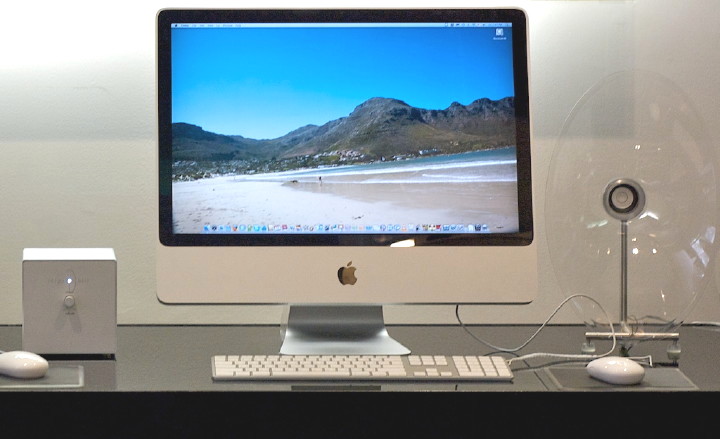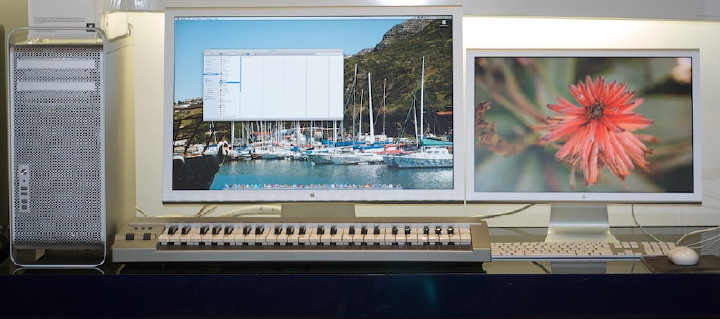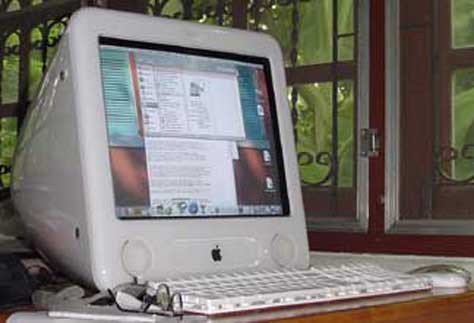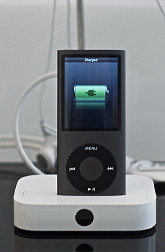|
|
Although Apple had made some popular computers for enthusiasts in its earliest days, the Mac was a total break with its mouse and the graphic user interface. Even then (as now) commentators made fun of the platform and suggested there was no evidence to support the idea that anyone would want to use a pointing device. I saw my first Mac in late 1985. I was only used to a PC that worked with command line MSDOS, and did not appreciate the strong tool I had before me. That one was used to create books: the author would lay up everything so that output was camera-ready and it was many years before I had such a sophisticated tool for my own.
As luck would have it, at Mahidol University, I had the chance to work with a couple of Mac users and when my last PC died, I was able to buy a used Mac Quadra as the owner was returning to the US. My switch to Macs occurred about the same time as Windows 3 was released. Once over the differences, I was able to work easily with the Mac which in those days was running System 7. In comparison to OS X, this seems somewhat archaic. Apple was aware of its limits and while the company was losing money with poor management and overpriced computers (a label that has still not been totally lost) it was also searching for a worthy operating system. Candidates on the way were Copland and Pink (which eventually became Taligent a joint IBM-Microsoft venture) as well as the BeOS which Apple almost bought in. In the meantime, Steve Jobs who had left Apple in 1985, had created NeXt and its NEXTSTEP operating system went live in 1988. Tim Berners-Lee created the first graphic browser on a NeXt machine at Cern in 1990, partly as a result of the developer software that was installed. With Apple wallowing, then CEO Gil Amelio acquired NeXt in early 1997. Along with NeXt came Steve Jobs and his team.
By 2000 the iMac was distributed with System 9 and the first versions of OS X. I finally saved up enough for my own iMac in early 2002 after some desktop Macs had arrived at work. I scared myself when I first looked at the new OS X, but tried again a few days later and quickly got to grips with it, writing my first Mac columns in May of that year. Distribution of Macs in Thailand in those days was handled by one company. Now there are several, while the local Apple office has expanded significantly. Head of operations here is Therdsak Skulyong who has a lot of experience in the computer industry in Thailand.

The retail section has also expanded here. While there were only a few outlets catering to a somewhat specialist clientele, now there are several shops in Bangkok, with some store expansion currently underway. The biggest expansion has been in the provinces, with several stores being established in cities that had no Apple presence in the past.
The latest development of the player was the iPhone which was finally introduced to Thailand, officially (unlocked versions had been available for many months in some sources here) in January of this year. This combines many functions of the iPod with some features of the PDA, plus camera and, of course, the functions of a modern mobile phone. Like the iPhone, the iPod and the Mac before it, the iTunes online music store was predicted to be a failure before the doors opened. Copyright issues have kept the store from many countries, including Thailand. The iPhone once established, and the iPod touch, now also allow applications to be installed, adding to the attractiveness and usefulness of these devices. As these applications do not have the same copyright issues as music or movies, Apple was able to establish a second tier operation online with the Apple Store and this became available to Thai users in July of 2008. A few months later, Apple also established an online store allowing those of us based in Thailand to purchase hardware, software and licences online, expanding access to Macs and Apple to all parts of the country.

The current range of Macs includes notebook computers and desktops, with the desktops being both for home and consumer use (the iMac) and professional use, the MacPro, an expandable heavyweight that is used by those making music, movies and by photographers. Apple has also expanded its professional software with offerings like Logic Studio, for music; Final Cut for making movies and Aperture for photography. Software for home users has also been developed and each Mac comes installed with a full range of applications so that we can start working out of the box. When the Post Database first started Apple was an exciting, if slightly quirky company that had a good product range, but which soon began to bleed money as outside factors, particularly the strength and popularity of Windows, took over the market. These days, while still a smaller company in terms of installed user base, Apple is still at the forefront of development and has consistently returned profits in the last few years. This January, while many other major companies are reporting major financial losses and laying off staff, Apple's First Quarter Financial results showed the best results ever, with revenue of $10.17 billion and record net quarterly profit of $1.61 billion. Apple has over $28 billion in the bank. Comments after the delivery of the outline results, show that 46% of Apple's revenue came from International sales. With the newer importance of overseas markets coupled with the way Apple has been expanding online services and links to social networking sites, we might expect to see some increased activity in the region as well as more features in the software that make the distance from Cupertino less of a problem than it was 22 years ago.
|
|

 For the celebration of 22 years of the Post Database, the editor asked me to look at how Macs and Apple have developed in that time, and by a wonderful coincidence, January saw the 25th anniversary of the Macintosh itself.
For the celebration of 22 years of the Post Database, the editor asked me to look at how Macs and Apple have developed in that time, and by a wonderful coincidence, January saw the 25th anniversary of the Macintosh itself. At that time, George Mann wrote a Mac column for the Post and it was really interesting to see how he produced this as the camera-ready output also displayed the menu systems and toolbars of the graphic interface.
At that time, George Mann wrote a Mac column for the Post and it was really interesting to see how he produced this as the camera-ready output also displayed the menu systems and toolbars of the graphic interface. When Jobs became interim CEO of Apple in late 1997, he began a series of changes that put Apple on track to return to a healthy condition and to become as innovative as its early history had been. Along with that strong Unix-based operating system that became OS X, design became of paramount importance. The iMac, in those days with a smoothed out triangular appearance, was one of the early results with its coloured sides. It had USB and Ethernet as standard at its introduction in 1998 with Firewire added in 2000. Apple dropped the 3.5" floppy disk which it had introduced with the first Macintosh in favour of a CD-ROM drive. Those first iMacs were $1299 (about 35,000 baht with the exchange rate then).
When Jobs became interim CEO of Apple in late 1997, he began a series of changes that put Apple on track to return to a healthy condition and to become as innovative as its early history had been. Along with that strong Unix-based operating system that became OS X, design became of paramount importance. The iMac, in those days with a smoothed out triangular appearance, was one of the early results with its coloured sides. It had USB and Ethernet as standard at its introduction in 1998 with Firewire added in 2000. Apple dropped the 3.5" floppy disk which it had introduced with the first Macintosh in favour of a CD-ROM drive. Those first iMacs were $1299 (about 35,000 baht with the exchange rate then). As well as the computers, Apple developed the iPod, a departure from its core business, but one that has seen tremendous success and increased sales worldwide. As with many Apple products, it integrates with other software installed on a Mac (or PC) and its use has been expanded over and above the basic music player.
As well as the computers, Apple developed the iPod, a departure from its core business, but one that has seen tremendous success and increased sales worldwide. As with many Apple products, it integrates with other software installed on a Mac (or PC) and its use has been expanded over and above the basic music player.